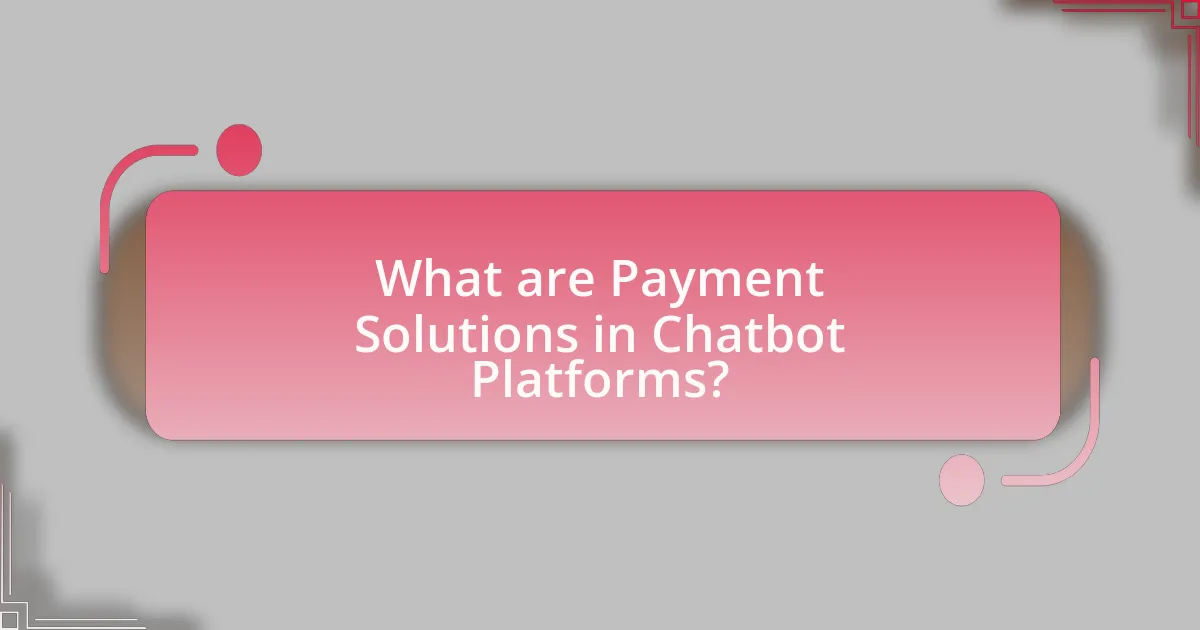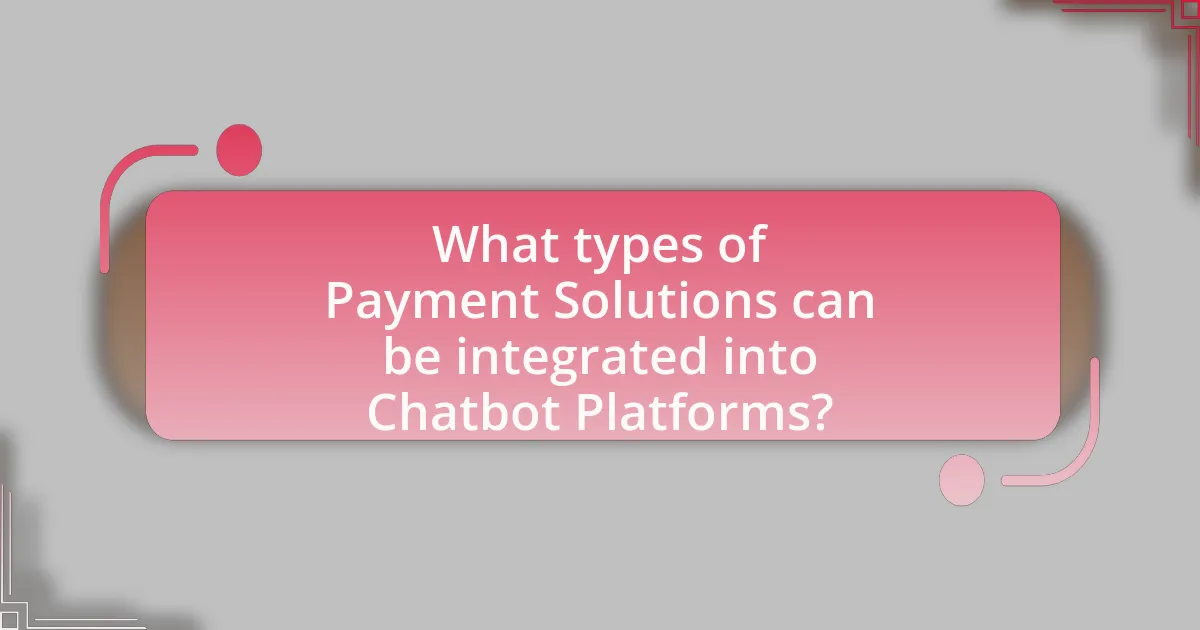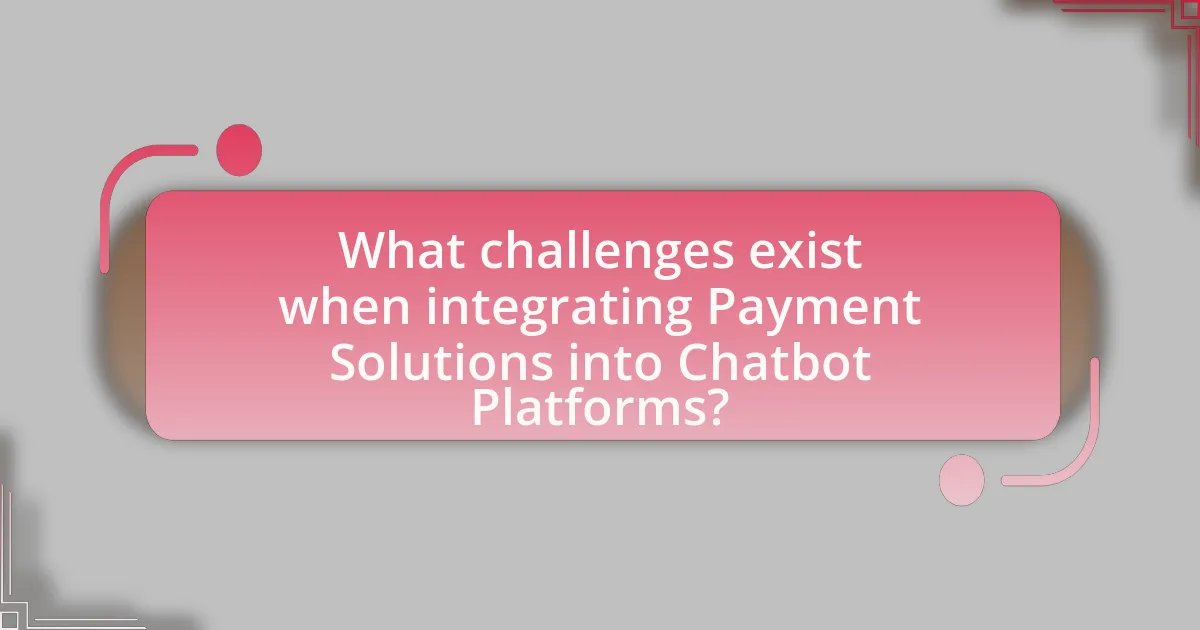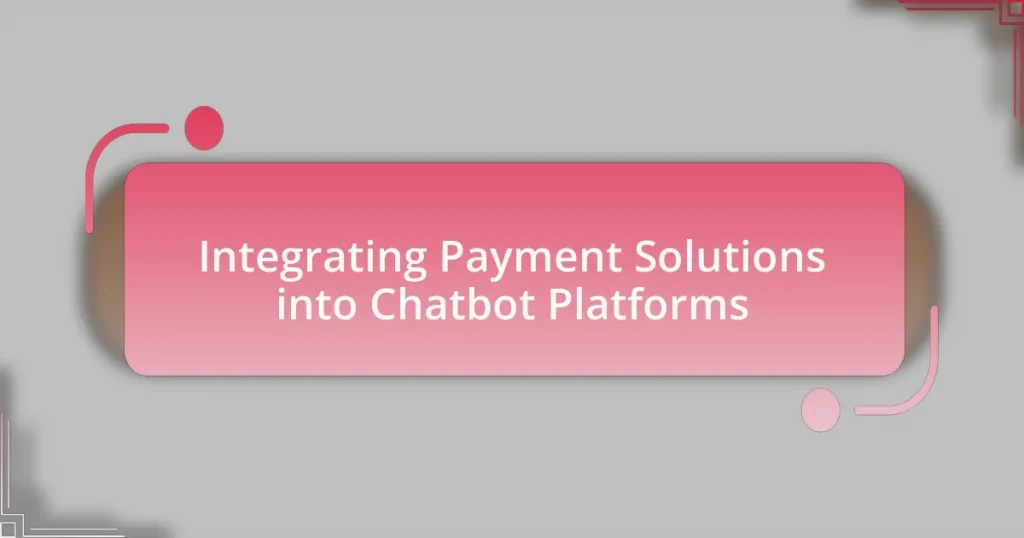Integrating payment solutions into chatbot platforms involves the incorporation of systems that enable financial transactions directly within chat interfaces. This article explores the various types of payment methods, such as credit cards, digital wallets, and subscription billing, and discusses the technologies and APIs that facilitate seamless payment processing. It highlights the importance of security, regulatory compliance, and user experience in the integration process, as well as the benefits businesses gain from enhanced efficiency and increased conversion rates. Additionally, the article addresses the challenges faced during integration and outlines best practices for successful implementation, emphasizing the role of user feedback in improving payment experiences.

What are Payment Solutions in Chatbot Platforms?
Payment solutions in chatbot platforms refer to the integrated systems that enable users to conduct financial transactions directly through chat interfaces. These solutions facilitate various payment methods, including credit and debit card processing, digital wallets, and bank transfers, allowing businesses to streamline customer interactions and enhance user experience. For instance, platforms like PayPal and Stripe offer APIs that can be embedded into chatbots, enabling secure and efficient payment processing. This integration not only simplifies the purchasing process for customers but also increases conversion rates for businesses, as evidenced by studies showing that chatbots can improve sales by up to 30%.
How do Payment Solutions integrate with Chatbot Platforms?
Payment solutions integrate with chatbot platforms through APIs that facilitate seamless transactions within conversational interfaces. These APIs allow chatbots to securely process payments, manage user authentication, and handle transaction confirmations in real-time. For instance, platforms like Stripe and PayPal provide SDKs that enable developers to embed payment functionalities directly into chatbots, ensuring a smooth user experience. This integration is validated by the increasing adoption of chatbots in e-commerce, where studies show that 67% of consumers prefer using chatbots for quick transactions, highlighting the effectiveness of such integrations in enhancing customer satisfaction and operational efficiency.
What technologies are involved in this integration?
The technologies involved in integrating payment solutions into chatbot platforms include Application Programming Interfaces (APIs), Natural Language Processing (NLP), secure payment gateways, and cloud computing. APIs facilitate communication between the chatbot and payment systems, enabling transactions to occur seamlessly. NLP allows chatbots to understand and process user queries related to payments, enhancing user experience. Secure payment gateways ensure that transactions are processed safely, protecting sensitive financial information. Cloud computing provides the necessary infrastructure for scalability and reliability in handling payment transactions. These technologies collectively enable efficient and secure payment processing within chatbot platforms.
How do APIs facilitate payment processing in chatbots?
APIs facilitate payment processing in chatbots by enabling seamless communication between the chatbot and payment gateways. This integration allows chatbots to securely handle transactions, retrieve payment information, and confirm payment statuses in real-time. For instance, when a user initiates a purchase through a chatbot, the API sends the transaction details to the payment processor, which then verifies and processes the payment. This method enhances user experience by providing instant feedback and reducing the need for manual intervention. Additionally, APIs ensure compliance with security standards, such as PCI DSS, which protects sensitive payment data during transactions.
Why is integrating Payment Solutions important for Chatbot Platforms?
Integrating payment solutions is crucial for chatbot platforms because it enables seamless transactions, enhancing user experience and driving sales. When payment solutions are integrated, users can complete purchases directly within the chat interface, reducing friction and increasing conversion rates. According to a study by Juniper Research, chatbots that facilitate payments can boost sales by up to 30%, demonstrating the financial impact of this integration. Furthermore, the ability to process payments within a chatbot allows businesses to provide 24/7 customer service, catering to consumer demands for convenience and immediacy.
What advantages do businesses gain from this integration?
Businesses gain increased efficiency and enhanced customer experience from integrating payment solutions into chatbot platforms. This integration allows for seamless transactions within the chat interface, reducing the need for customers to navigate away from the conversation to complete purchases. According to a study by Juniper Research, chatbots can handle up to 80% of routine customer inquiries, which streamlines operations and reduces operational costs. Additionally, the integration can lead to higher conversion rates, as customers are more likely to complete purchases when the payment process is simplified and immediate.
How does it enhance user experience in chatbot interactions?
Integrating payment solutions into chatbot platforms enhances user experience by providing seamless and efficient transaction capabilities within the chat interface. This integration allows users to complete purchases or payments without leaving the conversation, reducing friction and saving time. According to a study by Juniper Research, chatbots that facilitate payments can increase customer satisfaction by up to 30% due to the convenience and speed they offer. Furthermore, the ability to handle transactions directly within the chat fosters a more engaging and interactive experience, encouraging users to utilize the chatbot for a wider range of services.

What types of Payment Solutions can be integrated into Chatbot Platforms?
Chatbot platforms can integrate various types of payment solutions, including credit card processing, digital wallets, bank transfers, and subscription billing services. Credit card processing allows users to make payments directly through the chatbot using their credit or debit cards, while digital wallets like PayPal, Apple Pay, and Google Pay enable quick transactions without entering card details. Bank transfers facilitate direct payments from a user’s bank account, and subscription billing services support recurring payments for ongoing services. These integrations enhance user experience by providing seamless and secure payment options, which are essential for e-commerce and service-based chatbots.
What are the most common payment methods used in chatbots?
The most common payment methods used in chatbots include credit and debit cards, digital wallets, bank transfers, and in-app purchases. Credit and debit cards are widely accepted due to their convenience and security, with platforms like Stripe and PayPal facilitating these transactions. Digital wallets, such as Apple Pay and Google Pay, are increasingly popular for their ease of use and quick processing times. Bank transfers are also utilized, especially for larger transactions, while in-app purchases are common in gaming and subscription services. According to a report by Juniper Research, mobile payments, including those made through chatbots, are expected to reach $4.5 trillion by 2023, highlighting the growing reliance on these payment methods in digital interactions.
How do credit card payments work within chatbot systems?
Credit card payments within chatbot systems function by integrating payment gateways that facilitate secure transactions. When a user initiates a payment through a chatbot, the system collects the credit card information and securely transmits it to the payment gateway for processing. This process typically involves encryption to protect sensitive data, ensuring compliance with standards such as PCI DSS (Payment Card Industry Data Security Standard).
Once the payment gateway verifies the card details and checks for sufficient funds, it communicates the transaction status back to the chatbot, which then informs the user of the outcome. This seamless interaction allows users to complete purchases directly within the chat interface, enhancing user experience and streamlining the payment process.
What role do digital wallets play in chatbot transactions?
Digital wallets facilitate secure and efficient transactions within chatbot platforms by enabling users to make payments directly through the chat interface. This integration streamlines the purchasing process, allowing customers to complete transactions without leaving the conversation, which enhances user experience and increases conversion rates. According to a study by Juniper Research, the use of digital wallets in mobile commerce is projected to reach $9 trillion by 2024, highlighting their growing importance in facilitating seamless transactions across various platforms, including chatbots.
How do subscription-based payment models function in chatbots?
Subscription-based payment models in chatbots function by allowing users to access premium features or services through recurring payments, typically on a monthly or annual basis. These models enable chatbot developers to monetize their offerings by providing tiered access to functionalities, such as advanced analytics, personalized interactions, or priority support. For instance, a chatbot may offer a free version with basic capabilities while charging a subscription fee for enhanced features, thus incentivizing users to upgrade for a better experience. This approach is supported by the growing trend of businesses adopting subscription services, with a report from Zuora indicating that subscription revenue has grown by over 400% in the past decade, highlighting the effectiveness of this model in generating consistent income for service providers.
What are the benefits of using subscription models for businesses?
Subscription models provide businesses with predictable revenue streams, enhancing financial stability and facilitating long-term planning. This model allows companies to build customer loyalty through ongoing relationships, leading to higher customer lifetime value. According to a study by Zuora, subscription-based businesses grow revenue 5 times faster than traditional businesses, highlighting the effectiveness of this model in driving growth. Additionally, subscription models can reduce customer acquisition costs, as retaining existing customers is generally less expensive than acquiring new ones. This combination of predictable income, customer loyalty, and cost efficiency makes subscription models highly beneficial for businesses.
How can chatbots manage recurring payments effectively?
Chatbots can manage recurring payments effectively by integrating automated payment processing systems that handle subscription billing and reminders. These systems utilize secure payment gateways to facilitate transactions, ensuring compliance with financial regulations such as PCI DSS. For instance, chatbots can schedule payments based on user preferences, send notifications for upcoming charges, and provide users with options to modify or cancel subscriptions. This approach enhances user experience and reduces the likelihood of missed payments, as evidenced by a study from Juniper Research, which found that automated payment solutions can decrease late payments by up to 30%.

What challenges exist when integrating Payment Solutions into Chatbot Platforms?
Integrating payment solutions into chatbot platforms presents several challenges, including security concerns, regulatory compliance, and user experience issues. Security is paramount, as chatbots handling financial transactions must protect sensitive data from breaches; for instance, the 2020 Verizon Data Breach Investigations Report highlighted that 86% of breaches involved financial data. Regulatory compliance is another significant challenge, as different regions have varying laws governing online payments, such as the General Data Protection Regulation (GDPR) in Europe, which mandates strict data handling practices. Additionally, ensuring a seamless user experience can be difficult, as users may find it cumbersome to navigate payment processes within a chat interface, potentially leading to abandoned transactions. These challenges necessitate careful planning and implementation to ensure successful integration of payment solutions into chatbot platforms.
What security concerns should be addressed during integration?
During the integration of payment solutions into chatbot platforms, key security concerns include data encryption, user authentication, and compliance with regulations such as PCI DSS. Data encryption ensures that sensitive information, such as credit card details, is securely transmitted and stored, mitigating the risk of data breaches. User authentication processes, such as two-factor authentication, help verify the identity of users, reducing the likelihood of unauthorized access. Compliance with regulations like PCI DSS is crucial, as it sets standards for protecting card information, and failure to comply can result in significant penalties. Addressing these concerns is essential to safeguard user data and maintain trust in the payment system.
How can businesses ensure data protection for users?
Businesses can ensure data protection for users by implementing robust encryption methods for data transmission and storage. Encryption protects sensitive information, such as payment details, by converting it into a secure format that can only be accessed by authorized parties. According to a 2021 report by the Ponemon Institute, organizations that employ encryption experience 50% fewer data breaches compared to those that do not. Additionally, businesses should comply with regulations such as the General Data Protection Regulation (GDPR) and the Payment Card Industry Data Security Standard (PCI DSS), which provide frameworks for safeguarding user data. Regular security audits and employee training on data protection practices further enhance the security posture, ensuring that user data remains confidential and secure.
What compliance regulations must be considered?
When integrating payment solutions into chatbot platforms, compliance regulations such as the Payment Card Industry Data Security Standard (PCI DSS), General Data Protection Regulation (GDPR), and the Electronic Fund Transfer Act (EFTA) must be considered. PCI DSS outlines security measures for handling credit card information, ensuring that payment data is protected during transactions. GDPR mandates the protection of personal data and privacy for individuals within the European Union, requiring explicit consent for data processing. EFTA governs electronic payments and provides consumer protections, ensuring transparency and security in electronic fund transfers. Adhering to these regulations is essential for legal compliance and to maintain user trust in payment processes.
What technical challenges might arise during integration?
Technical challenges during integration of payment solutions into chatbot platforms include compatibility issues, security vulnerabilities, and data handling complexities. Compatibility issues arise when the payment solution does not seamlessly integrate with the existing chatbot architecture, potentially leading to functionality breakdowns. Security vulnerabilities can occur if the integration does not adhere to industry standards, exposing sensitive user data to breaches. Data handling complexities involve ensuring accurate transaction processing and managing user data across different systems, which can lead to errors if not properly addressed. These challenges are critical as they can impact user experience and trust in the payment system.
How can developers troubleshoot common integration issues?
Developers can troubleshoot common integration issues by systematically identifying and resolving errors in the integration process. First, they should review error logs and messages generated during the integration to pinpoint specific issues. Next, they can validate API keys, endpoints, and credentials to ensure they are correctly configured, as incorrect settings are a frequent source of problems. Additionally, developers should test the integration in a controlled environment to replicate issues and observe behavior under various conditions. They can also consult documentation for both the payment solution and the chatbot platform to ensure compliance with integration requirements. Finally, engaging with community forums or support channels can provide insights from other developers who may have encountered similar issues, enhancing problem-solving efficiency.
What testing methods are effective for ensuring smooth payment processing?
Effective testing methods for ensuring smooth payment processing include unit testing, integration testing, and user acceptance testing. Unit testing verifies individual components of the payment system, ensuring that each function operates correctly. Integration testing assesses the interaction between different modules, confirming that they work together seamlessly. User acceptance testing involves real users testing the payment process to identify any issues before deployment. These methods collectively enhance the reliability and efficiency of payment processing systems, as evidenced by industry practices that prioritize thorough testing to minimize transaction failures and enhance user experience.
What best practices should be followed for successful integration?
Successful integration of payment solutions into chatbot platforms requires a clear strategy that includes thorough planning, robust security measures, and user-friendly interfaces. First, organizations should conduct a comprehensive needs assessment to identify specific requirements and functionalities necessary for the integration. This ensures that the payment solution aligns with the chatbot’s purpose and user expectations.
Next, implementing strong security protocols, such as encryption and compliance with standards like PCI DSS, is crucial to protect sensitive payment information. According to a report by the Payment Card Industry Security Standards Council, adherence to these standards significantly reduces the risk of data breaches.
Additionally, testing the integration extensively before deployment is essential to identify and resolve any issues that may arise. A study by the International Journal of Information Management highlights that thorough testing can improve user satisfaction and reduce transaction failures.
Finally, providing clear user guidance and support enhances the overall user experience, making it easier for customers to navigate payment processes within the chatbot. By following these best practices, organizations can achieve a successful integration of payment solutions into their chatbot platforms.
How can user feedback improve payment integration in chatbots?
User feedback can significantly enhance payment integration in chatbots by identifying pain points and user preferences. When users provide insights on their experiences, developers can pinpoint specific issues such as transaction failures or confusing interfaces. For instance, a study by the Journal of Business Research found that 70% of users are more likely to engage with a chatbot that addresses their concerns effectively. By analyzing this feedback, developers can implement targeted improvements, such as streamlining the payment process or enhancing security features, ultimately leading to increased user satisfaction and higher transaction completion rates.
What strategies can enhance the overall payment experience for users?
To enhance the overall payment experience for users, integrating seamless payment solutions within chatbot platforms is essential. This can be achieved by implementing user-friendly interfaces that simplify the payment process, ensuring that users can complete transactions with minimal steps. Additionally, offering multiple payment options, such as credit cards, digital wallets, and bank transfers, caters to diverse user preferences and increases convenience.
Moreover, incorporating real-time transaction updates and confirmations within the chatbot enhances transparency and builds user trust. According to a study by the Baymard Institute, simplifying the checkout process can reduce cart abandonment rates by up to 70%. Therefore, optimizing the payment experience through these strategies not only improves user satisfaction but also drives higher conversion rates.










